Sinking a Staysee for Winter Bass
How Cody Murray targets deep fish in the reservoirs of Idaho
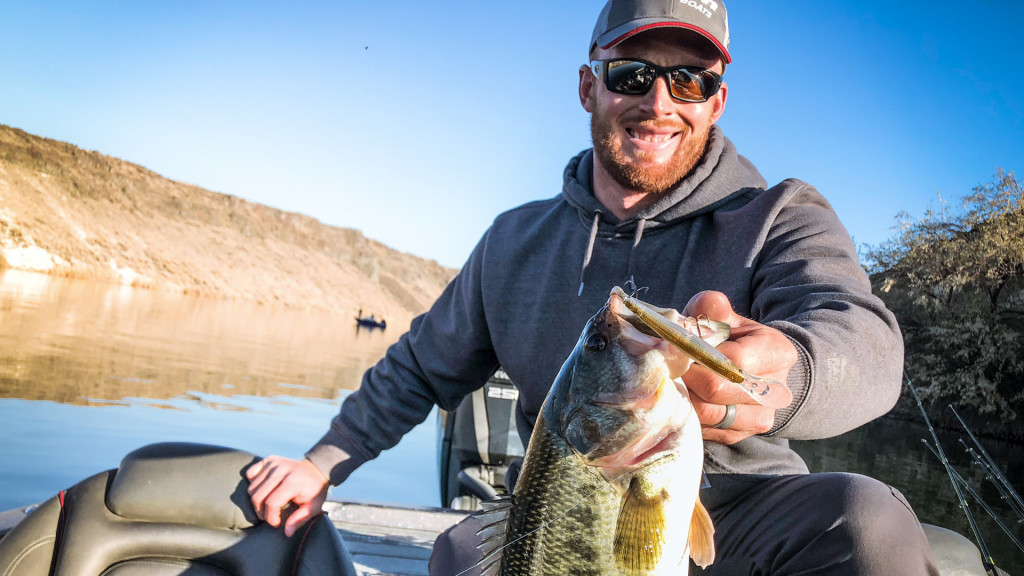
Fishing late and early in the season is often challenging. Because the water is cold, it can take a lot more patience to find fish or to coax them into biting. If you truly want to put your patience to the test, you might consider fishing a jerkbait ultra-slow. If you want to try for superhuman patience, you might want to fish a jerkbait like Cody Murray.
Hailing from Idaho, Murray doesn’t simply twitch and pause. He weights his jerkbaits and sinks down to depths greater than 25 feet.
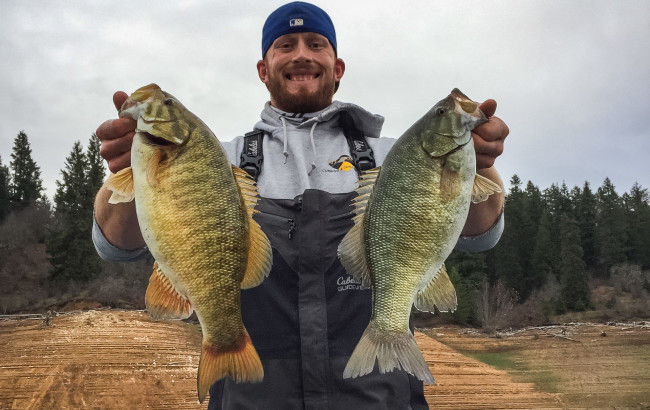
How it started
Back in 2000, Murray ran across an article about Curt Lytle winning a tournament on Table Rock with a weighted Smithwick Rogue. That got his brain ticking and started his obsession with weighting jerkbaits.
Most folks might give up easy on the idea of sinking a bait down at a slow pace in the cold, but Murray’s education in tournament fishing via angler Don Larson primed him from the start.
“Don was a cop and a trophy hunter, so he knew the virtues of patience,” relays Murray. “When I started fishing tournaments with him when I was 11 he gave me a split-shot rig on a spinning rod and told me I was going to throw that until I won a tournament. He said it would teach me patience and finesse, and those two things would take me far. The first tournament I ever fished with him he won on a split-shot rig, and I caught zero keepers. I just noticed, through fishing with him, that I fished fast and was impatient, and he fished super slow and caught fish.”
Eventually, Murray won a derby on a split-shot rig and was allowed to move on. Luckily, he never forgot how key patience can be. Over the years, Murray has refined weighting jerkbaits to an impressive degree and caught piles of smallmouths and largemouths on them during Idaho winters.
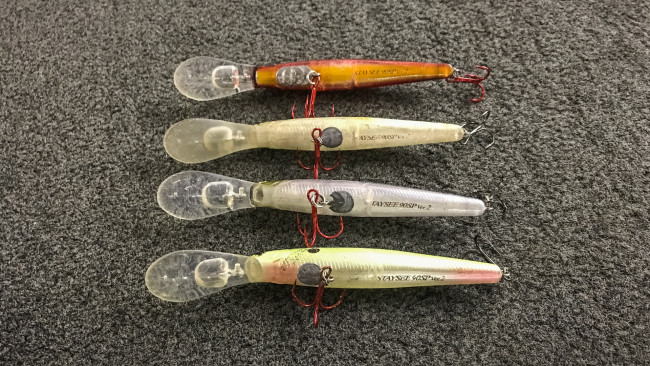
The bait
Murray essentially fishes a weighted jerkbait two ways. One is with a slow-sinking, very patient retrieve. The other is a faster-sinking, slightly more aggressive retrieve. For both techniques, he modifies the same jerkbait.
The Lucky Craft Staysee 90 SP Version 2 is Murray’s mainstay. It has a big bill to help it dive, a soft action when he works it, and it catches bass. Before adding any other weight, Murray always changes the hooks, going with a red No. 4 Owner ST-36 treble on the front and a regular No. 6 Owner ST-36 on the back. Already, those hooks are heavier than stock, but Murray doesn’t stop there. Depending on his situation, he’ll add anywhere from one to three Storm SuspenDots to the bait to really sink it down.
Typically, Murray will place one or two SuspenDots right behind the front hook, but he’ll sometimes go with three dots in front of the hook. Three dots will really sink the bait quickly, and putting them toward the front of the bait keeps the nose down so he can fish it faster without it rising.
Murray says he’s messed around with sinking jerkbaits and other deep-diving, suspending models, but he keeps coming back to the Staysee.
“I really think the bait is important,” adds Murray. “I think the movement of the bait and the way the bill is make it good. It deflects well when you twitch it, but the action is kind of muted. It will pull to one side, but it doesn’t have a ton of erratic action.
“I will play with this a lot,” Murray says about his offering. “If I have a whole day on the water I’ll fiddle. There are times I’ll cut a SuspenDot in half to add just a bit of weight. You can really spend a lot of time perfecting it if you want to.”
He’ll use a spectrum of colors, but his best producers are chartreuse shad, ghost minnow and aurora red. He says that red is particularly good in the spring and for kicker smallmouths.
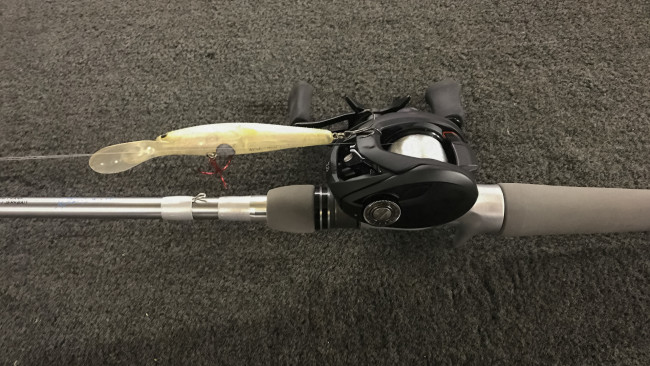
Tackle up
Murray sticks with 8-pound-test fluorocarbon, a 6.3:1 gear ratio Daiwa Tatula 100 and a 7-foot, medium-light Daiwa Tatula Elite casting rod. Because the bait ends up being decently heavy, casting it isn’t an issue, but a baitcaster gives him better line control than a spinning outfit would.
“Sometimes I’ll get bumped three or four times on the cast before one actually commits to the bait,” explains Murray. “What I like about the baitcaster is if I feel like I want to keep it there, or drop it back down to the fish, I can hit the button and free-spool the line or pull some out and keep it there. I feel like, usually, if they were active enough to come find it, if I can work the bait a few more times I can get them to commit.”

Setting the scene
Fishing mostly mountain reservoirs, Murray starts to look for a jerkbait bite when the water temperature drops below 50 degrees, and then again when it climbs back above 40 degrees. In Idaho, that means he’s jerking in November and December and then picking it up again sometime in February for another month or so. The lakes Murray fishes look a lot like the lower end of Lake Havasu – almost canyons, where you can usually see anyone fishing across the lake with ease.
When the jerkbait bite is on, the water is typically clear, with up to 10 feet of visibility. Though most of the places he fishes are reservoirs and not natural lakes, none of them has much flow to speak of. Almost all of his home fisheries support both smallmouths and largemouths, but as is often the case in the winter, the two species don’t always overlap.
Finally, though the following scenarios may sound a bit cut and dried, it’s still jerkbait fishing. Playing with cadences is always going to be important. Adding weight just complicates the matter more, so it’s a technique that requires an open mind on any given day.
One dot
Murray’s favorite way to throw a Staysee is with just one SuspenDot. It’s slightly more versatile and gets the majority of his use.
One of the primary ways he applies a slowly sinking bait is for fish that are suspended over deep water.
“In the spring I can meter an area and find fish on the graph suspended over a point or something,” says Murray. “And if the fish are 30 or 40 feet down, maybe over 60 or 80 feet, I can find those fish. If I throw that bait with one dot and let it have enough time I can usually catch those fish. Sometimes I can crank it down, and then it might be a pause as long as a minute, and I can catch them.”
When he’s fishing for strictly suspended bass, Murray often isn’t actually getting the bait to them. He reckons he can get the bait with one dot to about 25 feet fairly effectively through a combination of reeling and sinking. Because the water is clear and the bait is moving slowly, the bass will come up to eat it. A swimbait on a jighead or something like that would fall too quickly through the sluggish bass, but a nearly immobile jerkbait will tempt them.
Another way Murray likes to apply the one-dot bait is along migration routes and places fish are forced to filter through.
“Oftentimes I’ll go and find the biggest changes,” says Murray, ‘like the biggest pieces of rock or a slide or one point. And I’ll sit in 20 to 25 feet and just parallel the bank and throw that rip bait, just leaving it there long enough to get bit.”
He says that fishing for bass that he hasn’t already marked on a graph often requires a cup of coffee during the retrieve, but it can pay off.
The single-dot bait is also Murray’s staple for just fishing slow and deep in the middle of guts, any places where he marks bait and along bluffs.
“The bluff fishing seems to come into play when you get weather that indicates the fish should be moving up and down,” says Murray. “They’ll move a lot faster on those bluffs. If I get a few warm days, it seems like I can fish the sunny side of the bluffs and the fish’ll eat.”
A lot of the real deep stuff that Murray targets is smallmouth water. He says in the winter, even when the water is frigid, the largemouths typically don’t get more than 16 or 18 feet deep.
“I think they stay shallow for the most part, but I can get them to eat that rip bait,” says Murray. “I throw it with a single dot, so it’s still a sinking jerkbait, but they’ll eat it when you can’t necessarily catch them on anything else. If you leave it paused long enough they’ll eat it, and I think the sinking motion might be key. It maybe triggers the natural response that they have to eat something dying.”

Two or three dots?!
When Murray sticks up a bait with three SuspenDots he’s creating a bait that actually sinks fairly quickly. As such, he needs to move it and fish it more aggressively to keep it from getting hung on the bottom.
“Usually when I fish it aggressively I’m fishing it not more than 25 feet down,” says Murray. “That’s about the deepest I want to fish it when it’s on the bottom.”
In this case, Murray makes sure he’s got a lure retriever with him just for safety’s sake because there’s no reason to lose a Lucky Craft if you don’t have to.
“Sometimes smallmouths will be in that zone and they’ll still really react,” says Murray. “I’ll sink it down there near the bottom and fish it at a fairly decent clip and keep it moving the whole time. I don’t know if it’s the bait or it’s just a reaction, but they’ll eat it. I’ve had times where you have to sink it with just two SuspenDots, and you need to do 15- or 30-second pauses.”
Typically, with one dot, Murray pauses the bait about 30 seconds between twitches all the time. With two or three dots, he pauses less and actually twitches the bait along with just a bit of (not too much) aggression.
When the fish are actually relating to the bottom and he’s using three dots, Murray often targets points, especially longer ones, and the breaks on deep flats. Just like one-dot fishing, the presence of bait is a highly sought-after factor.
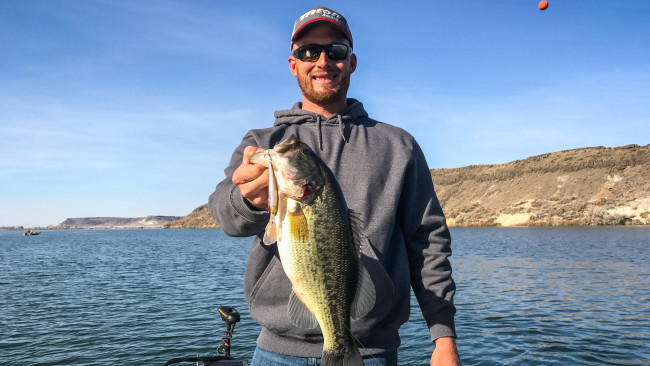
Be prepared
Weighting jerkbaits and fishing them as deep as Murray does is not easy.
“If you try this and give it 10 minutes you’ll never catch a fish on it,” he says, and he’s not wrong.
Slow wintertime fishing requires dedication and confidence to excel. But, just because it’s a tall task doesn’t mean you should ignore weighting baits altogether. You might not live in Idaho, but there’s a good chance you could think more about how your jerkbaits sink while fishing around home if you wanted to. If a little experimentation buys you a few extra fish or a more thorough understanding of the bait it might be worth it.